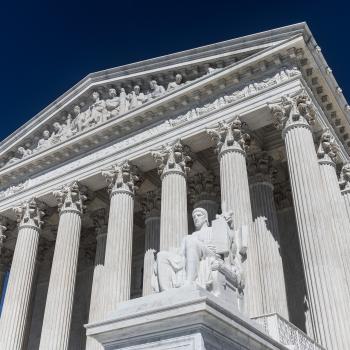At this point, I’m not sure how many people are still following this review series. The entire story sort of went up in smoke and became extremely repetitive, at the same time. We’re extremely close to the end now, and I’m open to suggestions for what I should do next.
For those maybe not quite following, the children’s rights activist/U.S. ambassador who pushed for the ratification of the U.N. Convention on the Rights of the Child went rogue after deciding that the U.N. Committee on the Rights of the Child cared only about power, not about children, and found herself dodging bullets as the committee chair sought to assassinate her (weirdly, she didn’t tell the press about this). This same committee chair had a Supreme Court Justice assassinated, and no one even noticed.
So now we come to the hearing before the U.S. Supreme Court, which is composed of only eight sitting justices (four liberal, three conservative, and one swing vote). This might have been interesting except that the only issue actually in play here is standing—whether two nonprofit agencies in the U.S. can sue on behalf of a child’s rights under the U.N. Committee on the Rights of the Child.
But hey, we still get stuff like this:
Every seat in the historic marble chamber was filled. … Cooper, dressed in a new black suit that Laura’s father had bought him or the occasion, was joined by Scott Gordon and Marian Nellis.
Is your fiancé’s father buying you a suit some sort of tradition I missed? Or are we just hammering again on how poor Cooper is, despite being a lawyer? Perhaps he shouldn’t have bought a new car using the blowout promised by Randall (his anonymous funder), before having a more secure cash flow?
I don’t even know anymore.
Suskins speaks first.
“The question before the Court today is whether the Supremacy Clause of the Constitution will be given the full dignity that its language demands. Treaties ratified by the Constitution are to be a part of the supreme law of the land,” he began.
Everything about this framing is wrong. This is not how this case would be argued. Unfortunately, this is now this whole chapter is written.
Well, that and things like this:
His hand wanted to flip his hair out of his eyes, but VanLandingham had gone to the two other name partners in the firm and gotten them to force Suskins to use some hairspray.
What. No she did not.
How do you force someone to wear hairspray? Wait—I just realized I don’t actually want to know.
Next, we get this whole bit, starting with a question from one of the justices:
“How can any component of your case survive unless we reverse Yoder?”
“There are three components of our case, and each will survive if we should prevail even if Yoder were retained as the prevailing law.
This book does not sound like it was written to be interesting to laypeople.
First, nothing in Yoder speaks to a parents’ ability to beat their child. And this Court has never upheld parental so-called spanking—”
“Council,” Justice Kurlowich interrupted, “you say ‘s0-called spanking.’ Did you ever get a spanking when you were a child?”
I’m sorry, why is this relevant?
“Yes, Your Honor, I did. But those were different times.”
The correct answer is: “Yes, Your Honor, I was spanked as a child. Over the last few decades, however, science has made clear that spanking causes children harm. Just as our nation once recognized that women should have the vote and that Jim Crow laws were unjust, it is time for us as a nation to adjust our views on the discipline of children. This understanding was at the heart of the Senate’s decision to ratify the U.N. Convention on the Rights of the Child.” But no, we don’t get any of that.
Suskins is horrible at persuasion. .
“Perhaps they were different times, but I am wondering if your family spoke a different language. When your father spanked you, did he call it a ‘spanking’?”
“Yes, he did, Your Honor. But I fail to see the point,” Suskins replied with a furrowed brow.
“The point is, Mr. Suskins, that you are trying to persuade us to your position by verbal tricks. Spanking is either constitutionally protected or it is not. Using the term ‘so-called spanking’ adds nothing to the strength of your argument, and in fact, your confession that your own parents spanked you highlights the long-standing nature of this parental tradition, which has been protected in law for more than four hundred years of Anglo-American jurisprudence.”
What in the blazes is this. Suskins would never have said “so-called spanking” to begin with. He would have said “corporal punishment” throughout. Beyond that, I thought it was common knowledge that different people and different communities use different terms to refer to corporal punishment. In African American communities, spanking is often referred to as giving “whooping”, but that’s not the only area different terms are used. Even Michael Pearl doesn’t always use the term “spanking.”
From Michael Pearl’s book:
We have progressed to the place where a discussion of the use of the rod is in order. Let’s talk about spankings–sometimes called “whippings.”
And indeed, Michael does use the term “whipping” in other areas of his book, as a synonym (one can assume) for spanking. “Spanking” is not some sort of universally correct and recognized term for corporal punishment. Farris likely prefers the term “spanking” because to him it feels sanitized—removed from terms like “whipping.” Fine. But Suskins should be using a term like “corporal punishment” or “physical discipline,” not “so-called spanking,” and no justice should be insisting that he say “spanking.”
This whole book is just ridiculously sloppy.
Next, Suskins says this:
“[W]e contend that the Constitution is a living document, and if long experience shows that child discipline practices become inextricably intertwined with child abuse and neglect, it is within the province of the United States Senate, by treaty, to ban abusive practices.”
That is also not how he would be arguing this. “[I]f long experience shows that child discipline practices become inextricably intertwined with child abuse and neglect”—what does that even mean? What child discipline practices? Presumably Farris means for Suskins to argue that corporal punishment has become “intertwined” with child abuse and that’s why it needs to be banned.
First, this isn’t the core point Suskins would make, the core point he would make is that no spanking is healthy for a child. Second, to the extent that this is a point made by children’s rictus activists—and it is—it needs to be explained in more detail. The argument, when not filtered through Farris’ mouth, is that as long as any form of corporal punishment is allowed, it will serve as a shield for abuse—abusive parents can claim they were only “spanking” their child, abused children may think that every child is beaten like they are because their friends also mention being “spanked” (without knowing that what their friends experience is light years from the abuse they experience), and so forth.
Instead, all we get is a truncated suggestion at a maybe-argument. For being such an elevated lawyer, Suskins is doing a horrible job. Anyway, moving on. There is more repetition. Lots more repetition.
The only thing particularly interesting that Farris puts in Suskins’ mouth is a reference to Prince v. Massachusetts, in which the Supreme Court barred Jehovah’s Witness children, but not their parents, from soliciting funds while passing out literature. Suskins argues that it is within the rights laid out in the Constitution to bar parents from teaching certain religion doctrines to their children, provided adults themselves are not barred from holding those beliefs. That is an actual relevant point.
And then there’s this:
“Counsel,” Justice McNeil interjected, “isn’t it a fact that the vast majority of religious groups who have filed amicus briefs in this matter supported your position?”
This is just bizarre. I cannot imagine a situation in which the “vast majority” of religious groups sign on with regulating what children may be taught in Sunday School. Even the ACLU would be all over this, submitting an amicus brief on behalf of the parents. Farris has no idea what people on the liberal end of the religious spectrum (or progressives in general) actually believe.
We also get lots of sentences like this:
Suskins sparred effectively with the conservatives on the Court and skillfully employed the friendly questions from the liberals to advance his argument for the remainder of his thirty minutes.
Finally, it’s Cooper’s turn. Once again, there is so much repetition.
The problem is that there are three court hearings, and in each case Farris chooses to cover them in full, outlining their entire oral arguments. But neither side changes what they are arguing. The result is that there is complete repetition of the exact same legal arguments each time. That makes for boring reading.
The only new thing here is this argument:
“Third, and this would be the ultimate disposition we desire, [for the Court] to rule that the original intent of the framers of the Constitution forbids the use of international treaties to govern America’s domestic’s policy. This use of the treaty power effectively trumps the principle of self-government. If unelected officials in Geneva are afforded the ability to control America’s domestic policy, constitutional government has been bargained away.”
Even here, it’s not that Farris has never said these things before. It’s just that here, he’s actually asking the Supreme Court to rule on this, because as the Supreme Court, they can.
Several justices note that the Court has never ruled anything close to this; Farris argues that this is a unique circumstance: “Our government has never before given away this much control over our internal affairs.” There’s lots more back and forth. What about NAFTA? Doesn’t that speak to domestic things as well, indirectly—doesn’t it give national sovereignty away too? Oh, but those are legislation, not treaties.
And so on and so forth.
“An argument worthy of the Senate, Counsel. But you are across the street in the Supreme Court of the United States.”
I feel like we’ve heard this line before, Oh wait, we have. This was stated in at least one—if not both—of the past two court hearings. Cool.
Cooper is adamant:
“This treaty doesn’t just violate one part of the Constitution; it violates the entire structure of the Constitution by allowing ten people in Geneva to decide that all the votes of all the voters in the United States do not matter, whether the ballots are cast for state or federal office holders.”
Cooper is also wrong. Because Farris is wrong.
The U.N. Committee on the Rights of the Child does not make decisions for the countries that have signed the treaty. It makes recommendations. Countries party to the treaty can choose whether and how to implement those recommendations. None of this is how any of this works.
And that’s the end of oral arguments. That very afternoon, the justices come together to vote on the case.
“Any discussion before we vote?” the chief justice asked.
“Suskins was his normal self, expect did anyone notice he didn’t flip his hair at all today? What was up with that? Hurter asked.
“I have to say that you had a feisty young man on your side of the case,” VonDuyke said with a grin.
This … what.
No. Just no.
So then they immediately go around the circle, and come up with a 4-4 split vote. Each justice offers a couple sentence justifying their position (well, most do; some don’t), but there is no discussion at all. No one tries to convince anyone else. No one weighs or considers their decision. The result is an affirmation of lower court’s decision. This means that the case is thrown out on standing—but could easily be brought again by a government agency, such as the National Commission on Children led by Nora Stoddard.
But let’s dwell for a moment on how odd it is that the justices went back to their chambers the moment the oral arguments finished and immediately took a vote on how to rule on the case. I did a bit of googling just now, and it appears that there is some variation—some cases take longer for the justices to decide than others—these conversations don’t typically occur the day of, and they typically involve arguments and attempts to persuade fellow justices, and, well, a bit more time.
If I were in the room, that feels like it would be the thing to question. Why the rush to vote now, today? Why can’t we have some time to try to persuade our fellows, and some back and forth, as is typical?
This is not, however, the critique the liberal justices raise. Instead, they raise a different critique. A bizarre critique. Justice McNeil addresses his question to Chief Justice Thomson, and this back and forth ensues:
“Can’t we just wait for Congressman Farenholt to be confirmed and then reschedule oral argument?” McNeil asked.
“No, Justice McNeil. We will not. We are an evenly decided court, and the decision of the Supreme Court of Virginia will be affirmed without an opinion of the Court.”
Is this even a thing—throwing out oral arguments after the fact and re-hearing the case? This suggestion is bizarre. It was perhaps worth asking, before the oral arguments, whether it made sense to have the case in the docket when it was—actually, I take that back. The Supreme Court doesn’t just stop hearing cases when it’s not a justice. Even before the oral arguments, that would have been a silly question.
This, though, is just ridiculous. And perhaps that’s how Farris sees liberals: as so ridiculous and unprofessional that they wouldn’t think twice about making a suggestion like this.
Justice McNeil makes one last attempt to stall:
“It will take me at least a month to prepare my dissent, and that will take me until Farenholt is confirmed. Then we’ll have his potential vote and we will have to do it again. So what’s the difference?”
Again, that does not make sense. It always takes time to prepare decisions and dissents, and there’s a process of drafts and editing—there will be many cases where a case is heard when the court is down one justice, and the decision is announced after a new justice is seated. That is simply how it works—and how else could it? Deciding cases and writing opinions takes time; Supreme Court decisions are frequently not announced until months after they are heard. This delay between oral arguments and the announcement is so large that most of the Supreme Court’s decisions aren’t released until the end of the term in June.
Chief Justice Thomson doesn’t go over any of this, though. He doesn’t point out that this is just how it works: sometimes you have only eight justices, and you don’t pause all proceedings until you have a ninth. Instead, Chief Justice Tomson treats the timing of the decision like some sort of power game:
“The difference is that I am the chief justice of the United States, and I control the docket of the Court unless there are five votes to overturn me. You have forty-eight hours to prepare your dissent. I will prepare the per curium decision that simply announces that we affirm without opinion. Nothing concerning this case will remain on our docket when Farenholt is confirmed. See you tomorrow at 9:30. Good day.”
I don’t think this is how it works.
None of this is how this works.
I have a Patreon! Please support my writing!















